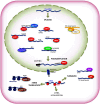Posttranscriptional regulation by RNA-binding proteins during epithelial-to-mesenchymal transition
- PMID: 23715860
- PMCID: PMC3827902
- DOI: 10.1007/s00018-013-1379-0
Posttranscriptional regulation by RNA-binding proteins during epithelial-to-mesenchymal transition
Abstract
Epithelial-to-mesenchymal transition (EMT), one of the crucial steps for carcinoma cells to acquire invasive capacity, results from the disruption of cell-cell contacts and the acquisition of a motile mesenchymal phenotype. Although the transcriptional events controlling EMT have been extensively studied, in recent years, several posttranscriptional mechanisms have emerged as critical in the regulation of EMT during tumor progression. In this review, we highlight the regulation of posttranscriptional events in EMT by RNA-binding proteins (RBPs). RBPs are responsible for controlling pre-mRNA splicing, capping, and polyadenylation, as well as mRNA export, turnover, localization, and translation. We discuss the most relevant aspects of RBPs controlling the metabolism of EMT-related mRNAs, and describe the implication of novel posttranscriptional mechanisms regulating EMT in response to different signaling pathways. Novel insight into posttranscriptional regulation of EMT by RBPs is uncovering new therapeutic targets in cancer invasion and metastasis.
Conflict of interest statement
There are no potential conflicts of interest.
Figures


References
-
- Adams CL, Nelson WJ. Cytomechanics of cadherin-mediated cell–cell adhesion. Curr Opin Cell Biol. 1998;10(5):572–577. - PubMed
-
- Perez-Moreno M, Jamora C, Fuchs E. Sticky business: orchestrating cellular signals at adherens junctions. Cell. 2003;112(4):535–548. - PubMed
-
- Yonemura S. Cadherin–actin interactions at adherens junctions. Curr Opin Cell Biol. 2011;23(5):515–522. - PubMed
-
- McCrea PD, Turck CW, Gumbiner B. A homolog of the armadillo protein in Drosophila (plakoglobin) associated with E-cadherin. Science. 1991;254(5036):1359–1361. - PubMed
Publication types
MeSH terms
Substances
LinkOut - more resources
Full Text Sources
Other Literature Sources

